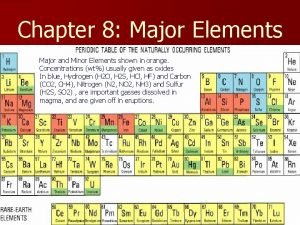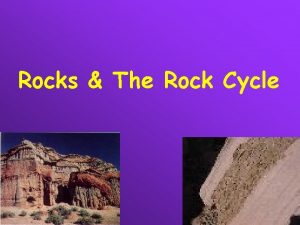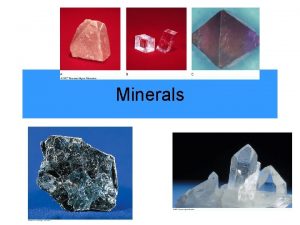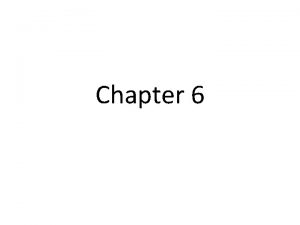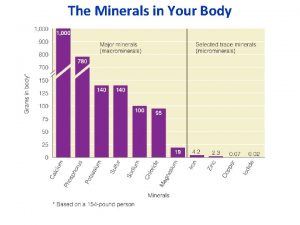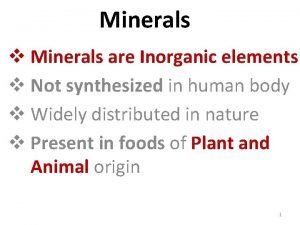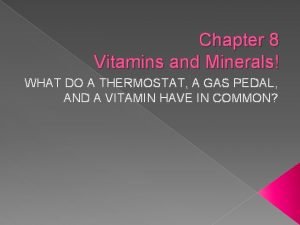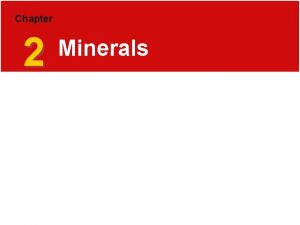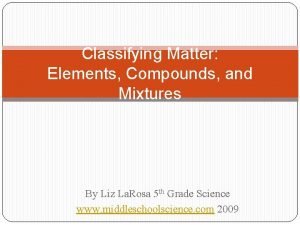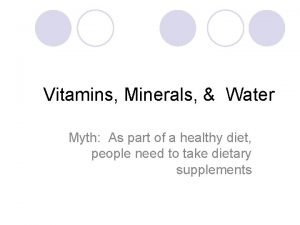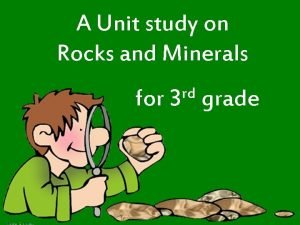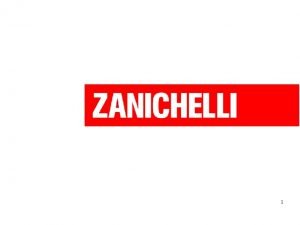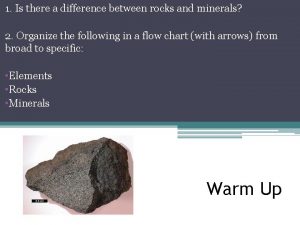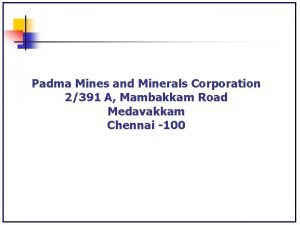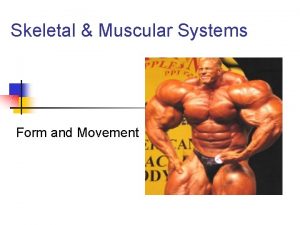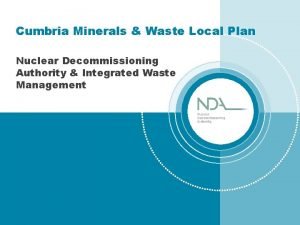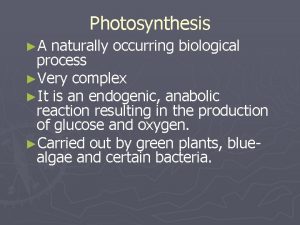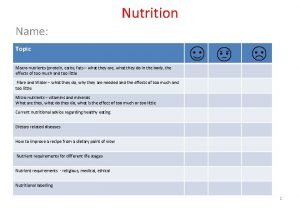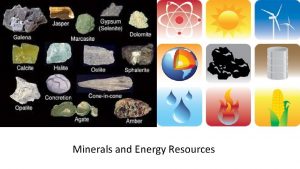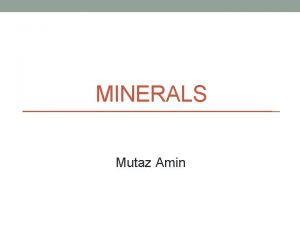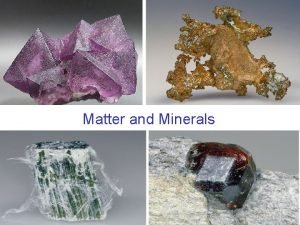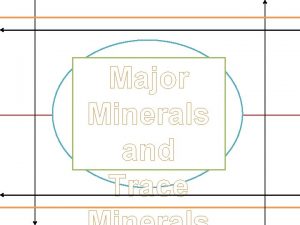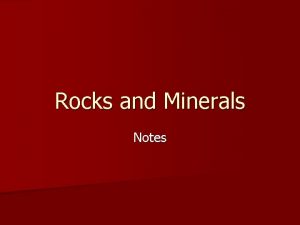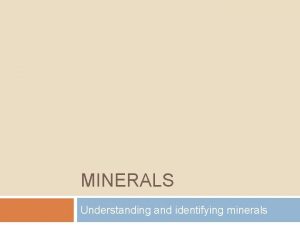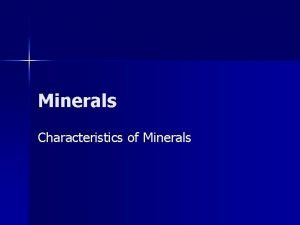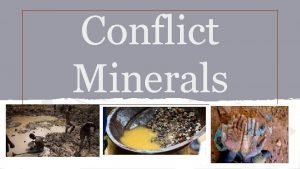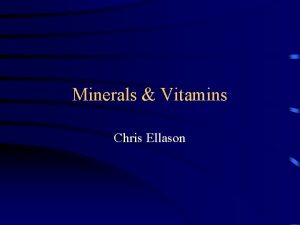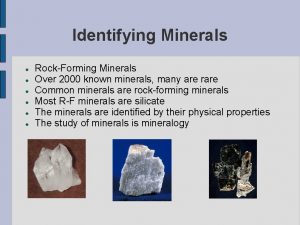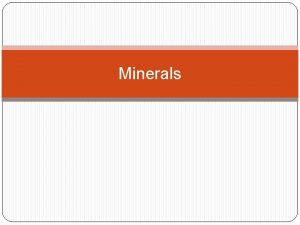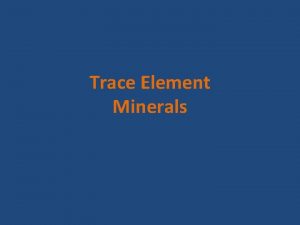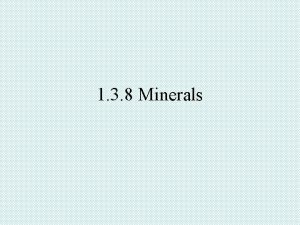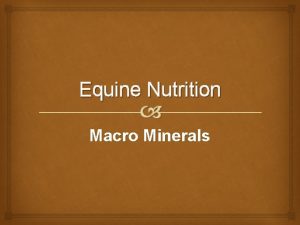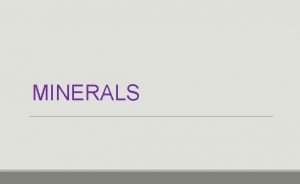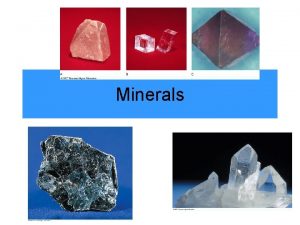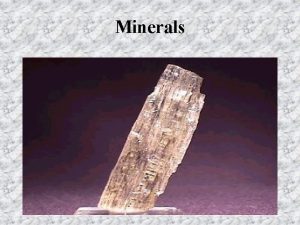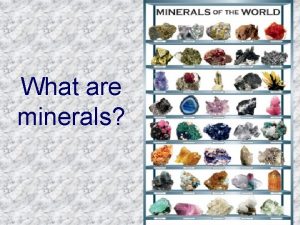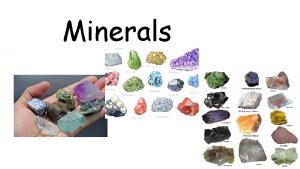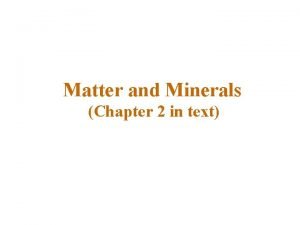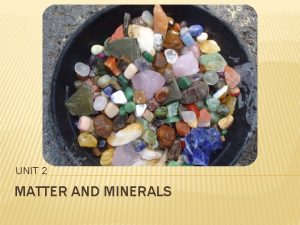Chapter 2 Minerals 2 1 Matter Elements and
































- Slides: 32

Chapter 2 Minerals

2. 1 Matter Elements and the Periodic Table _____ are the basic building blocks of minerals. Over 100 elements are known.

2. 1 Matter Atoms Smallest particles of matter Have all the characteristics of an element The ______ is the central part of an atom and contains • ____, which have positive electrical charges • _____, which have neutral electrical charges

2. 1 Matter Atoms __________, or shells • surround the nucleus • contain electrons—negatively charged particles The _______is the number of protons in the nucleus of an atom.

Model of an Atom

2. 1 Matter Isotopes ____ of an element have the same number of protons but varying numbers of neutrons. Have different mass numbers: the sum of the neutrons plus protons Many isotopes are radioactive and emit energy and particles. The _________is the number of neutrons and protons in the nucleus of an atom.

2. 1 Matter Why Atoms Bond When an atom’s outermost energy level does not contain the maximum number of electrons, the atom is likely to form a _______with one or more atoms. • A ________ consists of two or more elements that are chemically combined in specific proportions. • An ___ is an atom that gains or loses electrons.

2. 1 Matter Types of Chemical Bonds 1. _____ bonds form between positive and negative ions. 2. ______ bonds form when atoms share electrons. 3. ______ bonds form when metal ions share electrons.

2. 2 Minerals Definition of a Mineral 1. Naturally occurring 2. Solid substance 3. Orderly crystalline structure 4. Definite chemical composition 5. Generally considered inorganic

2. 2 Minerals How Minerals Form 1. Crystallization from magma 2. Precipitation 3. Pressure and temperature 4. Hydrothermal solutions

Minerals Formed as a Result of Crystallization of Magma

2. 2 Minerals Mineral Groups Can be classified based on their composition 1. Silicates • Silicon and oxygen combine to form a structure called the _______-_______. This silicon-oxygen tetrahedron provides the framework of every silicate mineral.

The Silicon-Oxygen Tetrahedron

Silicon-Oxygen Chains, Sheets, and Three-Dimensional Networks

2. 2 Minerals Mineral Groups 2. Carbonates • Minerals that contain the elements carbon, oxygen, and one or more other metallic elements 3. Oxides • Minerals that contain oxygen and one or more other elements, which are usually metals

2. 2 Minerals Mineral Groups 4. Sulfates and Sulfides • Minerals that contain the element sulfur 5. Halides • Minerals that contain a halogen ion plus one or more other elements 6. Native elements • Minerals that exist in relatively pure form

Sulfides

Native Copper

2. 3 Properties of Minerals Color Small amounts of different elements can give the same mineral different colors.

2. 3 Properties of Minerals Streak _____ is the color of a mineral in its powdered form.

2. 3 Properties of Minerals Luster _____ is used to describe how light is reflected from the surface of a mineral.

Pyrite (Fool’s Gold) Displays Metallic Luster.

2. 3 Properties of Minerals Crystal Form Crystal form is the visible expression of a mineral’s internal arrangement of atoms.

Quartz Often Exhibits Good Crystal Form.

2. 3 Properties of Minerals Hardness ____ is a measure of the resistance of a mineral to being scratched. _______consists of 10 minerals arranged from 10 (hardest) to 1 (softest).

Mohs Scale of Hardness

2. 3 Properties of Minerals Cleavage ______ is the tendency of a mineral to cleave, or break, along flat, even surfaces.

Mica Has Cleavage in One Direction

2. 3 Properties of Minerals Fracture Minerals that do not show cleavage when broken are said to fracture. ______the uneven breakage of a mineral

Conchoidal Fracture

2. 3 Properties of Minerals Density ______ is a property of all matter that is the ratio of an object’s mass to its volume.

2. 3 Properties of Minerals Distinctive Properties of Minerals Some minerals can be recognized by other distinctive properties.
 What are the elements of major and minor minerals
What are the elements of major and minor minerals Chapter 2 section 1 classifying matter answers
Chapter 2 section 1 classifying matter answers Rock vs mineral
Rock vs mineral Biotitie
Biotitie Elements are moved between minerals during metamorphism by:
Elements are moved between minerals during metamorphism by: Minerals are inorganic elements that the body
Minerals are inorganic elements that the body Iron deficiency anemia smear
Iron deficiency anemia smear Whats gray matter
Whats gray matter Label the cranial dura septa and associated sinuses.
Label the cranial dura septa and associated sinuses. Gray matter and white matter
Gray matter and white matter Rhinencephalon
Rhinencephalon Chapter 8 vitamins and minerals
Chapter 8 vitamins and minerals Classification of matter section 1 composition of matter
Classification of matter section 1 composition of matter Section 1 composition of matter
Section 1 composition of matter Section 1 composition of matter chapter 15 answer key
Section 1 composition of matter chapter 15 answer key Energy naturally flows from warmer matter to cooler matter
Energy naturally flows from warmer matter to cooler matter Chapter 2 minerals
Chapter 2 minerals Classifying elements compounds and mixtures
Classifying elements compounds and mixtures Function of minerals
Function of minerals Gneiss
Gneiss Difference between rocks and minerals
Difference between rocks and minerals Difference between minerals and rocks
Difference between minerals and rocks Concept map of different types of rocks
Concept map of different types of rocks Suzanna socked me sunday poem
Suzanna socked me sunday poem Absorbs water and minerals
Absorbs water and minerals Difference between rock and stone
Difference between rock and stone Padma mines and minerals corporation
Padma mines and minerals corporation Stores minerals and anchors muscles
Stores minerals and anchors muscles Cumbria minerals and waste local plan
Cumbria minerals and waste local plan Resource that can be replaced
Resource that can be replaced Minerals and fuels
Minerals and fuels Minerals sources functions and deficiency chart
Minerals sources functions and deficiency chart Minerals and fuels
Minerals and fuels
